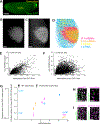Sequence-Independent Self-Assembly of Germ Granule mRNAs into Homotypic Clusters
- PMID: 32464092
- PMCID: PMC7325742
- DOI: 10.1016/j.molcel.2020.05.008
Sequence-Independent Self-Assembly of Germ Granule mRNAs into Homotypic Clusters
Abstract
mRNAs enriched in membraneless condensates provide functional compartmentalization within cells. The mechanisms that recruit transcripts to condensates are under intense study; however, how mRNAs organize once they reach a granule remains poorly understood. Here, we report on a self-sorting mechanism by which multiple mRNAs derived from the same gene assemble into discrete homotypic clusters. We demonstrate that in vivo mRNA localization to granules and self-assembly within granules are governed by different mRNA features: localization is encoded by specific RNA regions, whereas self-assembly involves the entire mRNA, does not involve sequence-specific, ordered intermolecular RNA:RNA interactions, and is thus RNA sequence independent. We propose that the ability of mRNAs to self-sort into homotypic assemblies is an inherent property of an messenger ribonucleoprotein (mRNP) that is augmented under conditions that increase RNA concentration, such as upon enrichment in RNA-protein granules, a process that appears conserved in diverse cellular contexts and organisms.
Keywords: RNA clusters; RNA granules; RNA phase separation; RNA self-assembly; RNA sorting; RNA:RNA interactions; germ granules; homotypic RNA assembly; nanos; oskar.
Copyright © 2020 Elsevier Inc. All rights reserved.
Conflict of interest statement
Declaration of Interests H.S. receives royalties, as co-inventor, from sales of iSIM by Visitech. The NIH, its officers, and staff do not recommend or endorse any company, product, or service.
Figures




Similar articles
-
Germ Granule Evolution Provides Mechanistic Insight into Drosophila Germline Development.Mol Biol Evol. 2023 Aug 3;40(8):msad174. doi: 10.1093/molbev/msad174. Mol Biol Evol. 2023. PMID: 37527522 Free PMC article.
-
Stochastic Seeding Coupled with mRNA Self-Recruitment Generates Heterogeneous Drosophila Germ Granules.Curr Biol. 2018 Jun 18;28(12):1872-1881.e3. doi: 10.1016/j.cub.2018.04.037. Epub 2018 May 31. Curr Biol. 2018. PMID: 29861136 Free PMC article.
-
An architectural role of specific RNA-RNA interactions in oskar granules.Nat Cell Biol. 2024 Nov;26(11):1934-1942. doi: 10.1038/s41556-024-01519-3. Epub 2024 Oct 1. Nat Cell Biol. 2024. PMID: 39354131 Free PMC article.
-
mRNP granules. Assembly, function, and connections with disease.RNA Biol. 2014;11(8):1019-30. doi: 10.4161/15476286.2014.972208. RNA Biol. 2014. PMID: 25531407 Free PMC article. Review.
-
Germ granules in Drosophila.Traffic. 2019 Sep;20(9):650-660. doi: 10.1111/tra.12674. Epub 2019 Jul 31. Traffic. 2019. PMID: 31218815 Free PMC article. Review.
Cited by
-
Intracellular mRNA transport and localized translation.Nat Rev Mol Cell Biol. 2021 Jul;22(7):483-504. doi: 10.1038/s41580-021-00356-8. Epub 2021 Apr 9. Nat Rev Mol Cell Biol. 2021. PMID: 33837370 Free PMC article. Review.
-
Cotranslational Mechanisms of Protein Biogenesis and Complex Assembly in Eukaryotes.Annu Rev Biomed Data Sci. 2022 Aug 10;5:67-94. doi: 10.1146/annurev-biodatasci-121721-095858. Epub 2022 Apr 26. Annu Rev Biomed Data Sci. 2022. PMID: 35472290 Free PMC article. Review.
-
Spatial organization of translation and translational repression in two phases of germ granules.Nat Commun. 2024 Sep 13;15(1):8020. doi: 10.1038/s41467-024-52346-x. Nat Commun. 2024. PMID: 39271704 Free PMC article.
-
Dendritically localized RNAs are packaged as diversely composed ribonucleoprotein particles with heterogeneous copy number states.bioRxiv [Preprint]. 2024 Aug 25:2024.07.13.603387. doi: 10.1101/2024.07.13.603387. bioRxiv. 2024. PMID: 39071419 Free PMC article. Preprint.
-
Computational modeling offers new insight into Drosophila germ granule development.Biophys J. 2022 Apr 19;121(8):1465-1482. doi: 10.1016/j.bpj.2022.03.014. Epub 2022 Mar 12. Biophys J. 2022. PMID: 35288123 Free PMC article.
References
-
- ARKOV AL, WANG JY, RAMOS A & LEHMANN R 2006. The role of Tudor domains in germline development and polar granule architecture. Development, 133, 4053–62. - PubMed
-
- BERGSTEN SE & GAVIS ER 1999. Role for mRNA localization in translational activation but not spatial restriction of nanos RNA. Development, 126, 659–69. - PubMed
-
- BERTRAND E, CHARTRAND P, SCHAEFER M, SHENOY SM, SINGER RH & LONG RM 1998. Localization of ASH1 mRNA particles in living yeast. Mol Cell, 2, 437–45. - PubMed
-
- BOLTE S & CORDELIERES FP 2006. A guided tour into subcellular colocalization analysis in light microscopy. J Microsc, 224, 213–32. - PubMed
-
- BRANGWYNNE CP, ECKMANN CR, COURSON DS, RYBARSKA A, HOEGE C, GHARAKHANI J, JULICHER F & HYMAN AA 2009. Germline P granules are liquid droplets that localize by controlled dissolution/condensation. Science, 324, 1729–32. - PubMed
Publication types
MeSH terms
Substances
Grants and funding
LinkOut - more resources
Full Text Sources
Molecular Biology Databases

